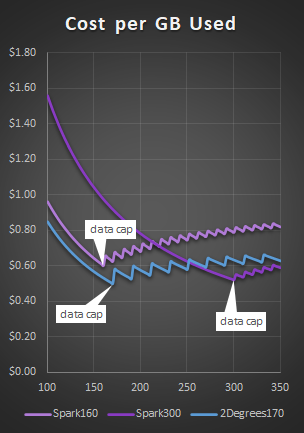The cost per unit normally comes down when you buy more of something. This it not always the case with rural broadband. The graph shows the price per GB usage can go up. Take 2Degrees as an example. The price per GB used actually goes up once you exceed 170GB. (May 2021 prices.)
Data caps and excess usage charges are a problem for many rural people.
As the CEO of Telecom NZ famously said in 2006, “Think about pricing. What has every telco in the world done in the past? It’s used confusion as its chief marketing tool. And that’s fine”. Data caps provide an unwelcome complication to consumers.
However data caps serve a purpose when there is not enough network capacity. Data caps help share out the limited resources in a fairer manor. The down side for the consumer is the hassle of regularly checking usage. Maybe even having to try policing usage by the kids (this is always going to be a losing battle.)
The network operators are often reluctant to invest in rural capacity upgrades because it might reduce profitability. Previously the govt has stepped in and funded some rural capacity upgrades. However the govt has acknowledged that the operators may now expect that the govt will continue to manage funding of investment gaps in broadband.
This year some high usage subscribers will move to Starlink because of the increased speed and lack of data caps. This will relieve some strain on the terrestrial networks (in the short term anyway).
What can you do?
Select the best technology for your usage and location:
- see the NZ Broadband map to find what might be available in your area
- see if there is a local WISP
- is VDSL availabile (usually fast and with no data cap)
- high data users might want to queue up for Starlink
Review your plan regularly.
Currently there are substantial differences between providers.
Avoid long contracts if possible.

There may be some delay before your comment is posted.
*name optional